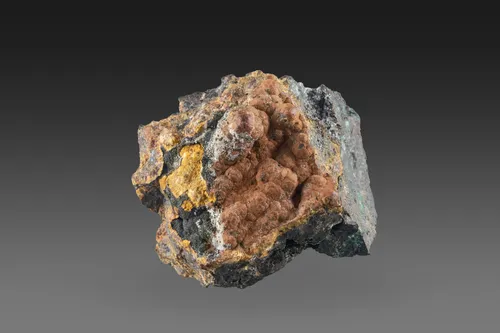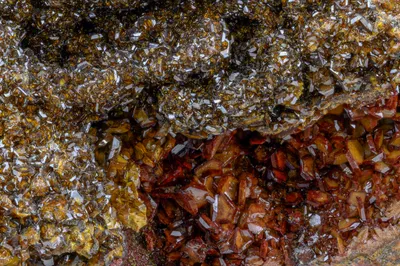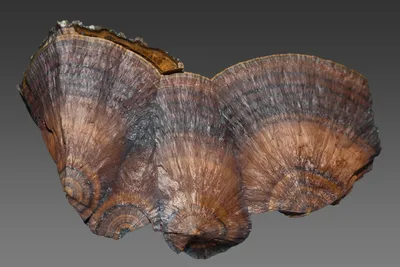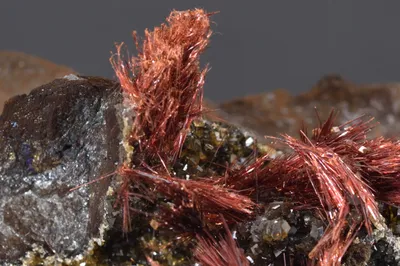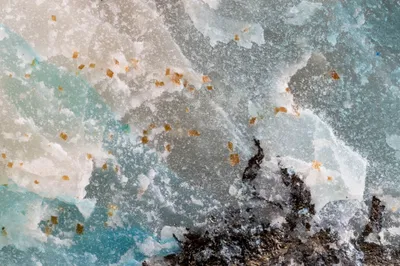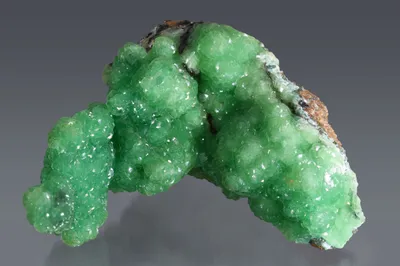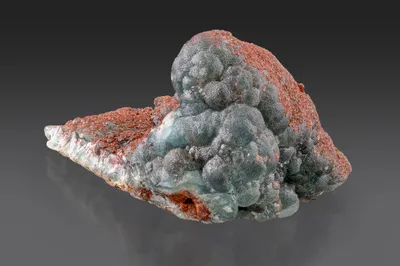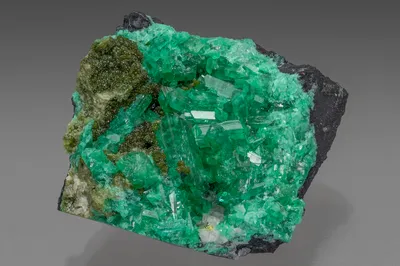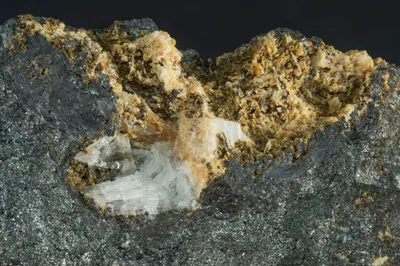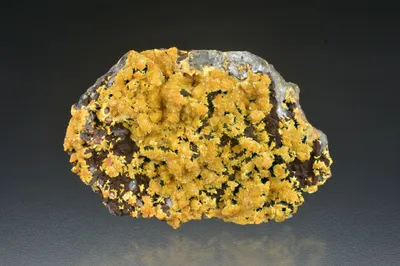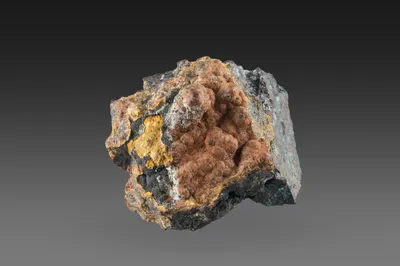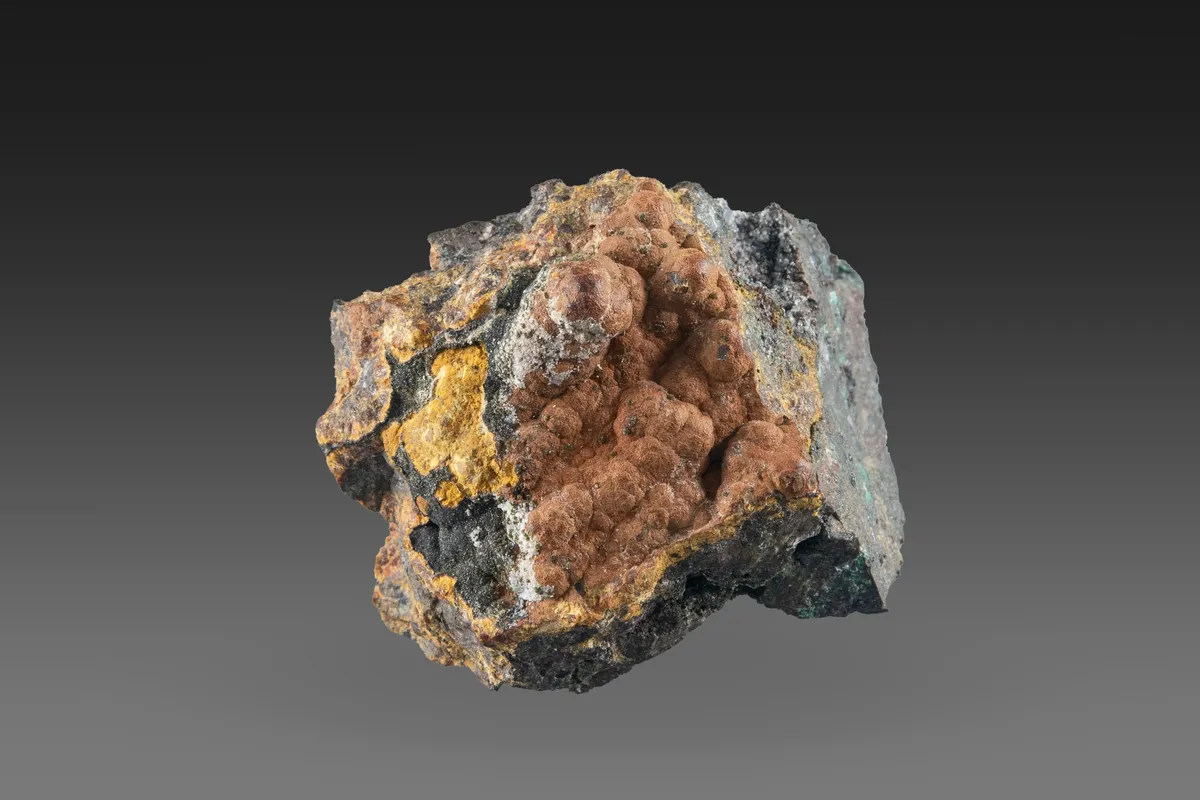
Image Credit: Malcolm Southwood
Mineral Species
Tsumcorite
Type Locality
Yes
Composition
Pb(Zn,Fe3+)2(AsO4)2(H2O,OH)2
Crystal System
Monoclinic
Status at Tsumeb
Confirmed (type locality)
Abundance
Somewhat rare
Distribution
First, second and third oxidation zones
Paragenesis
Supergene
Entry Number
Species; TSNB356
Type Mineralogy
In 1964 mining on 30 Level at East 49 encountered a cavernous portion of the ore body hosted by cherty dolomite breccia. The cavities were lined with crystalline crusts rich in beudantite, with anglesite and mimetite, and minor amounts of arseniosiderite, beaverite, carminite, pharmacosiderite and scorodite. There was also a mineral that could not be identified but analysis in the Tsumeb Corporation laboratory showed it to be a Pb-Fe-Zn arsenate. Further study at the University of Karlsruhe in Germany confirmed that it was a new mineral. Intriguingly, two samples of the same mineral, also from Tsumeb, were made available from the Natural History Museum in London (BM.1925,567 and BM.1929,93). The London specimens had been presented to the NHM in the 1920s by German mineral dealer Wilhelm Maucher, erroneously identified as sideronatrite but, some thirty years later, provided confirmation that the new mineral had also occurred in the first oxidation zone. Tsumcorite, IMA 1969-047, was described by Geier et al. (1971) and named after the Tsumeb Corporation Ltd in appreciation of the company’s encouragement of geological and mineralogical research. Geier et al. (1971) proposed the formula PbZnFe(AsO4)2·H2O, however, structural refinements (notably by Tillmanns and Gebert, 1973a, 1973b) led to the modern formula Pb(Zn,Fe3+)2(AsO4)2(H2O,OH)2 (Back 2022). There appears to be no registered type specimen (http://www.handbookofmineralogy.org/; accessed December 2022. https://www.ctms-jack.ch/list-of-minerals.html; accessed March 2023); however, a relatively large volume of material collected by Geier at the time of the original discovery has been dispersed among public and private collections variously labelled as "type material" or "part of holotype".
General Notes
Tsumcorite is a member of the tsumcorite group of minerals (Krause et al. 1998) which comprises structurally related monoclinic and triclinic arsenates, phosphates, vanadates and sulphates with a total of 24 species listed by Back (2022). Nine of these species have been reported from Tsumeb (as of June 2022), with six of them sharing Tsumeb as the type locality (bold type): cobalttsumcorite; ferrilotharmeyerite; gartrellite; helmutwinklerite; lukrahnite; mawbyite; thometzekite; tsumcorite; zincgartrellite.
Excellent examples of tsumcorite were encountered between 28 and 30 levels, with arguably the best find from 30 level, where bright yellow crystals to 5 mm are perched on red-brown iron oxides (Gebhard, 1999).
On the material from the original discovery tsumcorite occurs as compact crusts from one mm to a few mm in thickness, associated with beudantite, anglesite, mimetite, and "other arsenates" (Geier et al. 1971). The tsumcorite crusts are red-brown in colour, but show yellow to yellow-green dichroism under the microscope.
Tsumcorite also occurs as feathery, powdery aggregates and as individual crystals.
Pinch and Wilson (1977) described:
"…bright lemon-yellow to dark yellow-brown and red-brown radially structured crusts and small tabular crystals. The individual crystals measure up to 0.2 x 0.5 x 0.1 mm and usually occur together in sheafs and bunches. A few distinct crystals to 2 mm have been found."
They also highlighted attractive combinations of tsumcorite with pale green willemite and suggest that "…the finest orange-brown crystals are found on apple-green smithsonite, or yellow mimetite crystals."
Keller (1977a) placed tsumcorite in one of his "Type II" parageneses (i.e., sequences forming under lower pH conditions):
II/6: primary sulphides >> conichalcite >> tsumcorite >> adamite >> smithsonite
Keller (1984) noted that crystals can be tabular or prismatic in habit, often tapering to a point, and to a maximum of 3 mm. He also noted the occurrence of tsumcorite as inconspicuous pale yellow powdery coatings (for example on tennantite) and as "… intense honey-yellow masses of fused radiating crystals."
Hochleitner (1987) documented a mid-1980s discovery of tsumcorite which arrived on the minerals market in 1986. The specimens comprise crusts of intergrown tsumcorite crystals over hematite-stained quartz and on tennantite-rich ore. The tsumcorite crystals are unusually well-formed to a few mm in size, slightly curved, with a lenticular habit and yellow-brown in colour. Tsumcorite crusts on tennantite ore were described as "loose" due to further decomposition of the sulphide which resulted in cavities that are partly filled with green zincolivenite. Visually, tsumcorite is easily confused with other species including ferrilotharmeyerite, gartrellite and zincgartrellite. Furthermore, Cairncross (2017b) noted the complex relationships between members of the tsumcorite group; tsumcorite forms series with helmutwinklerite (where Zn replaces Fe3+), thometzekite (where Cu replaces Zn and Fe3+) and mawbyite (where Zn is replaced by Fe3+). Because of these complex relationships and visual similarities analysis is required for certain identification.
An overview of the occurrence of tsumcorite at Tsumeb was provided by Cairncross (2017b).
Associated Minerals
adamite; anglesite; aragonite; arsendescloizite; arseniosiderite; arsentsumebite; azurite; beaverite-(Cu); beudantite; brochantite; calcite; carminite; cerussite; conichalcite; dolomite; duftite; fahleite; ferrilotharmeyerite; gartrellite; goethite; gypsum; hematite; hemimorphite; jamesite; leiteite; ludlockite; metazeunerite; mimetite; o’danielite; parasymplesite (?); pharmacosiderite; philipsbornite; prosopite; quartz; rhodochrosite (?); rosasite; scorodite; smithsonite; spertiniite; tennantite-(Zn); warikahnite; willemite; wroewolfeite (?); wulfenite; zincolivenite; zincroselite
